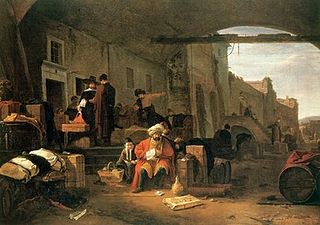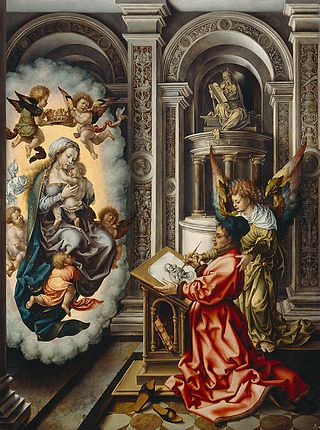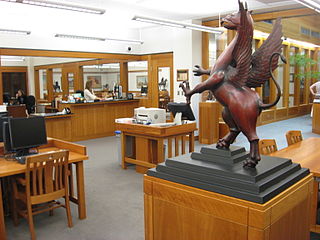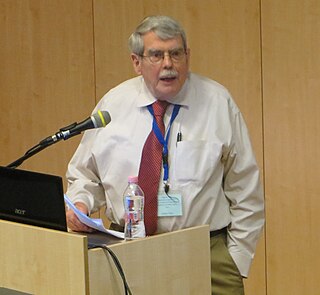
The Hanseatic League was a medieval commercial and defensive network of merchant guilds and market towns in Central and Northern Europe. Growing from a few North German towns in the late 12th century, the League expanded between the 13th and 15th centuries and ultimately encompassed nearly 200 settlements across eight modern-day countries, ranging from Estonia in the north and east, to the Netherlands in the west, and extended inland as far as Cologne, the Prussian regions and Kraków, Poland.

A merchant is a person who trades in commodities produced by other people, especially one who trades with foreign countries. Merchants have been known for as long as humans have engaged in trade and commerce. Merchants and merchant networks operated in ancient Babylonia, Assyria, China, Egypt, Greece, India, Persia, Phoenicia and Rome. During the European medieval period, a rapid expansion in trade and commerce led to the rise of a wealthy and powerful merchant class. The European Age of Discovery opened up new trading routes and gave European consumers access to a much broader range of goods. By the 18th century, a new type of manufacturer-merchant had started to emerge and modern business practices were becoming evident.

Brigham Young University (BYU) is a private research university in Provo, Utah, United States. It was founded in 1875 by religious leader Brigham Young and is sponsored by the Church of Jesus Christ of Latter-day Saints.

Leonard James Arrington was an American author, academic and the founder of the Mormon History Association. He is known as the "Dean of Mormon History" and "the Father of Mormon History" because of his many influential contributions to the field. Since 1842, he was the first non-general authority Church Historian for the Church of Jesus Christ of Latter-day Saints, from 1972 to 1982, and was director of the Joseph Fielding Smith Institute for Church History from 1982 until 1986.

Hugh Winder Nibley was an American scholar and member of the Church of Jesus Christ of Latter-day Saints who was a professor at Brigham Young University (BYU) for nearly 50 years. He was a prolific author, and wrote apologetic works supporting the archaeological, linguistic, and historical claims of Joseph Smith. He was a member of the LDS Church, and wrote and lectured on LDS scripture and doctrinal topics, publishing many articles in the LDS Church magazines.
The Steelyard, from the Middle Low German Stâlhof, was the kontor of the Hanseatic League in London, and their main trading base in England, between the 13th and 16th centuries. The main goods that the League exported from London were wool and from the 14th century woollen cloths. An important import good was beeswax. The kontor tended to be dominated by Rhenish and Westphalian traders, especially from Cologne.

The Guild of Saint Luke was the most common name for a city guild for painters and other artists in early modern Europe, especially in the Low Countries. They were named in honor of the Evangelist Luke, the patron saint of artists, who was identified by John of Damascus as having painted the Virgin's portrait.

Alice Louise Reynolds was a Brigham Young University (BYU) professor. Reynolds furthered her studies out east, receiving a bachelor's degree from the University of Michigan. She taught college-level courses at Brigham Young Academy until it dissolved into BYU, and she was the first woman to do so. She was the second woman in Utah to be named a full professor, and the first woman to be a full professor at BYU. She worked to establish the library at Brigham Young Academy, and through her efforts, she was able to collect over 100,000 donated volumes. She worked as an editor for the Relief Society Magazine and contributed to other LDS Church-affiliated magazines. Reynolds was an outspoken Democrat and served on the party's committee and as a delegate to the party's national convention. Reynolds died in 1938 of cancer.
Esnaf is a Turkish word which means "corporation". During the Early Modern Period belonging to a guild gave people a voice and was an important part of one's identity. Handicraft producers were linked to one another by a range of social, political, and economic ties. Guilds varied among societies, social class, and genders. There were many misconceptions, differences, as well as similarities between Europe and the Ottoman Empire. There were hierarchies within guilds; sometimes they shared tools, worked together, or worked alone.
Richard Olsen Cowan is a historian of the Church of Jesus Christ of Latter-day Saints and a former professor in the Church History Department of Brigham Young University (BYU). He was one of the longest-serving BYU faculty and the longest-serving member of the Church History Department ever.

The L. Tom Perry Special Collections is the special collections department of Brigham Young University (BYU)'s Harold B. Lee Library in Provo, Utah. Founded in 1957 with 1,000 books and 50 manuscript collections, as of 2016 the Library's special collections contained over 300,000 books, 11,000 manuscript collections, and over 2.5 million photographs, among many other rare and unique research materials. Since its inception, the special collections have been housed in numerous places including the crawl space of a university building and a wholesale grocery warehouse. Since 2016, the special collections have been located on the first floor of the Harold B. Lee Library and is considered to hold "the finest collection of rare books in the Intermountain West and the second finest Mormon collection in existence".
Grant Revon Underwood is a historian of the Church of Jesus Christ of Latter-day Saints and a professor at Brigham Young University (BYU). He is also the author of The Millennial World of Early Mormonism and the editor of Voyages of Faith: Explorations in Mormon Pacific History.
The Religious Studies Center (RSC) at Brigham Young University (BYU) sponsors and publishes scholarship on the culture, history, scripture, and doctrine of the Church of Jesus Christ of Latter-day Saints.
The Sixteenth Century Society and Conference (SCSC) is a learned society that promotes research on the early modern period. The society is interdisciplinary in membership, welcoming scholars in history, art history, religion, history of science, musicology, dance history, and literary and cultural studies in English, French, German, Italian, and Spanish. Founded in 1969, its initial officers included Kyle Sessions as president and Miriam Usher Chrisman as vice president.
The BYU Division of Continuing Education (DCE) is a division of Brigham Young University (BYU) that oversees continuing education programs.

Antwerp is a city and a municipality in the Flemish Region of Belgium. It is the capital and largest city of Antwerp Province, and the third largest city in Belgium by area at 204.51 km2 (78.96 sq mi) after Tournai and Couvin. With a population of 536,079, it is the most populous municipality in Belgium, and with a metropolitan population of over 1,200,000 people, the country's second-largest metropolitan region after Brussels.

The following outline is provided as an overview of and a topical guide to the Church of Jesus Christ of Latter-day Saints.

The Ottoman decline thesis or Ottoman decline paradigm is an obsolete historical narrative which once played a dominant role in the study of the history of the Ottoman Empire. According to the decline thesis, following a golden age associated with the reign of Sultan Suleiman the Magnificent, the empire gradually entered into a period of all-encompassing stagnation and decline from which it was never able to recover, lasting until the dissolution of the Ottoman Empire in 1923. This thesis was used throughout most of the twentieth century as the basis of both Western and Republican Turkish understanding of Ottoman history. However, by 1978, historians had begun to reexamine the fundamental assumptions of the decline thesis.

James Donald Tracy is an American historian. With Heiko A. Oberman, he was co-founder of the Journal of Early Modern History, and editor from 1999 through 2010. He has served as president of the Sixteenth Century Society and Conference, the Society for Reformation Research, and the American Catholic Historical Association. At the University of Minnesota, he was associate dean of the College of Liberal Arts, chaired the Department of History, and held the Union Pacific Chair in Early Modern History from 2001 to 2004. Upon his retirement, Tracy was granted emeritus status. Among early modernists he is known for his contributions to an unusual range of research areas.











